teenage engineering OP-Z
The OP-Z is a powerful little box capable of a huge variety of things, with the best sequencer on the market - but with such great power comes a bit of a learning curve.
Pros
- Great sound
- Huge amount of functionality
- Extremely portable
Cons
- Steep learning curve
In the past issue, we’ve already had our hands on the excellent teenage engineering POM-400 synth and POM-16 sequencer, and after being blown away by how excellent and full of surprises they were, we were raring for more. Thankfully, the amazing folks at teenage engineering provided us with a review unit of the OP-Z and the first bit of expansion kit designed for it – the oplab module.
Now, let’s get into what exactly the OP-Z is – since it’s quite the little package! At its core is a 16-track sequencer capable of sequencing a wide array of things. Around it are four drum track engines, capable of loading a 24-sample pack, four synth tracks, capable of loading one of the multiple available synth engines. These synth tracks each also feature a powerful PCM sampler. Next come the two effect racks, a “tape” track, the master track, and finally, we have the unique performance, module, DMX light, and motion tracks.
Looking at the physical form factor, the OP-Z is tiny. Compared to the already semi-pocketable POM-16, the OP-Z is the same width, but half the thickness and almost half the height. It also feels extremely solid in the hand, with an injection-moulded IXEF 1022 PARA polyarylamide-based resin, reinforced with 50% glass fibre by weight. This is a unique decision, but it gives the svelte device serious structural integrity. The material also gives each OP-Z a streaky marbled surface finish, which teenage engineering claims to be unique on every single device – which is certainly endearing!
The front plate of the OP-Z houses an array of buttons and rotary encoders, but unlike some previous devices by the company, there’s no display. Instead, teenage engineering opted for an optional companion app that runs on iOS, Android, and macOS and connects to the OP-Z via Bluetooth. This is an elegant solution, though. The OP-Z works perfectly fine standalone, as all the app does is visualise the many pages of settings and parameters available. We’ve found ourselves relying less and less on it as time went on, relying instead on the extremely clever way in which the OP-Z itself presents data using its array of LEDs.
The rotary encoders are also worth mentioning, as they are extremely high-end custom magnetic encoders with ball bearings, and they feel so amazing to operate. This might sound like a minor thing, but since these four disks are used in almost all parameter tweaking, encoder feel shapes a huge part of the OP-Z experience.
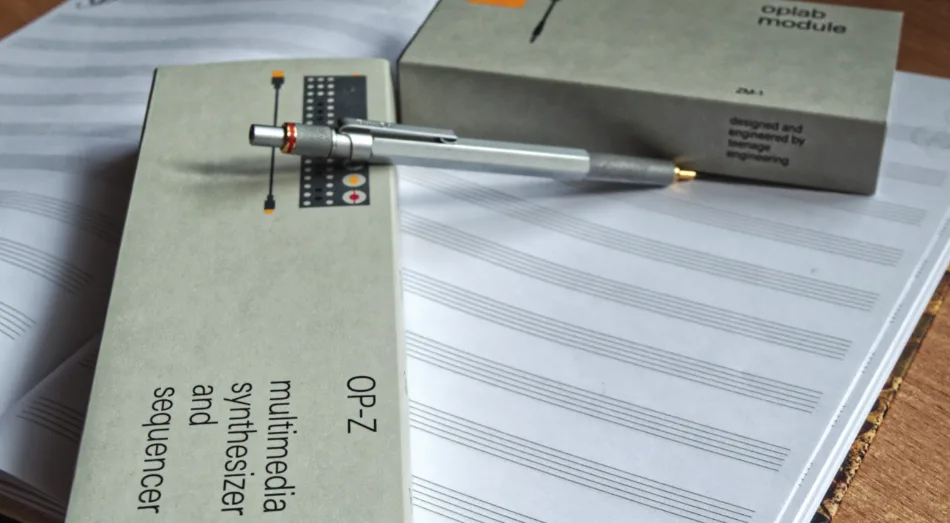
On the left side of the device are the signature yellow combination power switch and volume knob, while along its bottom side is an interesting pressure-sensitive nub that allows for pitch bending and some more functionality while sequencing. There’s a 3.5 mm audio jack and a USB-C port (way to go!) on the right, while on the top side there are four buttons that bring up important system-wide submenus – the project view, mixer, metronome, and “screen” mode.
There’s also an on-board 2-in-2-out audio interface for exporting projects onto a computer for further work. The OP-Z can also accept a single cartridge-like expansion that adds functionality or IO to the device. The rechargeable battery is user-replaceable – and the entire back cover is held in place by rubber thumb screws. This is a rare, but welcome sight in today’s era of non-user-replaceable parts.
We’d also like to mention that the battery life is pretty decent. We’ve been getting around 5 to 6 hours of use with Bluetooth on, and slightly more without. The battery also charges very quickly.
This all sounds plenty impressive, but it doesn’t even begin to scratch the surface of what this gorgeous bit of kit can do. Let’s break down the features in-depth, one by one, and see what makes many of them unique.
The Sequencer
At the heart of the OP-Z lies undoubtedly its powerful sequencer. It’s a 16-track, 16-step sequencer (which can actually be pushed to 384 steps, but more on that in a second) with incredible features. Each of the 16 tracks is fully independent, capable of running at different speeds and having a custom number of steps. Many sequencers would struggle here, but if having one sequence with 7 steps, one beat long each simultaneously playing with another sequence with 5 steps, three beats long each is just what you’re after, the OP-Z has you covered. This effectively enables creatively complex rhythms and ever-changing combinations with even the tiniest bit of material.
Each main step is further subdivided into 24 subdivisions, making a total of 384 steps accessible per sequence. Each of these 384 steps can also sequence up to 4 notes at a time. This is ample space for complex melodies and chord progressions – and is among the most robust options offered in the industry. Aside from simply offering more notes, these additional steps offer timing resolution and can be used as places to “nudge” the note’s position, allowing for sequences that feel inherently more human.
Steps on the OP-Z can either be manually and precisely entered right into the sequencer or live-recorded. There is a robust quantisation option, though. One tiny drawback to using all 384 steps is the need to live-record them. The physical sequencing grid only allows for up to 16 steps per pattern. A bit of a shame – but something a firmware update can certainly bring to the table!

Everything created on the OP-Z is saved within projects onto onboard storage. Each of these projects can contain up to 16 patterns each (think of patterns as loops – a pattern contains a sequence per each track and all track settings), and these can be chained in any order, effectively enabling entire pieces to be written start-to-finish using the sequencer. Completed pattern chains can be saved to one of ten slots. For live performance, patterns can also be manually cued, with the OP-Z intelligently blending the previous one with the next.
But there’s more. So much more.
See, while 384 steps per sequence are plenty impressive – the OP-Z goes above and beyond by bringing a little bit of science into the mix with step components. Step components offer a logic diagram-like approach to per-step manipulation and are immensely powerful. Namely, they offer a way to change up a sequence in such a way that each consecutive repetition sounds different and tweak single steps as desired.
Components like pulse and pulse hold allow lengthening singular steps up to 9x their length, while components like ramp up, ramp down, and random offer a way to randomise the note played during the step itself. Possibly the most powerful components are the three spark components – parameter spark, component spark, and trigger spark. These tell the sequencer to read parameter locks, apply component sparks or read notes themselves only on particular repeats of the sequence. For example, you could have steps 1,3, and 7 playing every 2nd pass, while steps 2 and 8 play only every 3rd pass, with the other steps playing normally. It’s quite a sophisticated system – one that allows for an unmatched degree of creativity while writing music on the OP-Z.

We’ve mentioned parameter locks in the previous paragraph, so let’s explain what they are about. Almost every parameter on the OP-Z, be it LFO settings, per-oscillator parameters, filters, effect sends (but with the notable omission of pitch bend) can also be sequenced. Aside from carrying up to four note values and any number of step components, a step can also carry a parameter lock.
Parameter locks basically tell the synth engines I don’t care what the settings right now are, but on this step they have to be exactly as stated in the lock. Parameter locks can be manually set by holding a step’s button and tweaking a parameter or can be live recorded. They are an extremely powerful addition to the already overkill sequencer, but they do fall a bit short compared to proper DAW-level automation, since they only read values up to 16 times per sequence. Thankfully, smooth filter sweeps (and similar such endeavours) can be easily achieved with the clever use of an LFO.
Finally, while the clicky buttons on the OP-Z don’t feature velocity (how on Earth would you manage to pack those in such a tiny device?), the OP-Z’s sequencer is perfectly capable of dealing with it. Holding down a step button and using the pitch bend nub (we hate calling it a “nub” but we seriously can’t find a better term) changes the velocity of the held step depending on the pressure applied. If using an external MIDI controller (which we recommend whenever possible – while the built-in keyboard is great on-the-go, it’s just a tad too small for more serious work), the OP-Z also fully supports and records velocity data.
There’s also a whole array of “punch-in effects”. These are implemented in a similar fashion to those found on te’s pocket operator devices (these are powerful, pocketable calculator-like noisemakers with a seriously big sound – we’ll encounter one later during this review). Basically, while the sequence is running, hit a button on the keyboard and watch as the OP-Z twists your sequence in various ways and applies various effects to the sound. It’s aimed more at live performance, but is nevertheless a worthy – and somewhat characteristic for the company – feature.
Overall, the sequencer on the OP-Z is insane. And we don’t throw such claims lightly. It’s among the ranks of the industry greats – like the Digitakt or Keystep, but in such a compact package that it feels almost magical.
The Synth Engines and Sample Packs
OP-Z isn’t just a sequencer. It’s also an extremely versatile drum machine, synthesiser and sampler. These are based on something teenage engineering calls “engines” – which are basically digital synthesis algorithms. To OP-1 users, some of these might be familiar already – like cluster, digital and volt, while some, like bow and electric are brand-new engines developed for the OP-Z. The OP-Z features 12 engines total, which each have two unique parameters, with the rest being the standard resonant filter, envelope, LFO and bus sends parameters. This is a bit of a step-down from OP-1’s 4-parameter setup, but it still offers a lot of versatility for getting some great and unique sounds.
Let’s quickly run down the list of available synth engines, together with our thoughts on what we think makes them work (teenage engineering doesn’t really document how these work internally, so we’re going off of what we saw on our scope and what we can hear).
Saw
The saw synth seems to be based around two modulating waves, with a hefty dose of filtering. Parameter 1 (P1) seems to control the attack of the note, while parameter 2 (P2) controls the colour of the sustain. It’s capable of producing some lovely chiptune-like lead sounds, but unique percussive-sounding synth-string style pads with the low values of P1 and high values of P2, with an appropriate envelope shape.
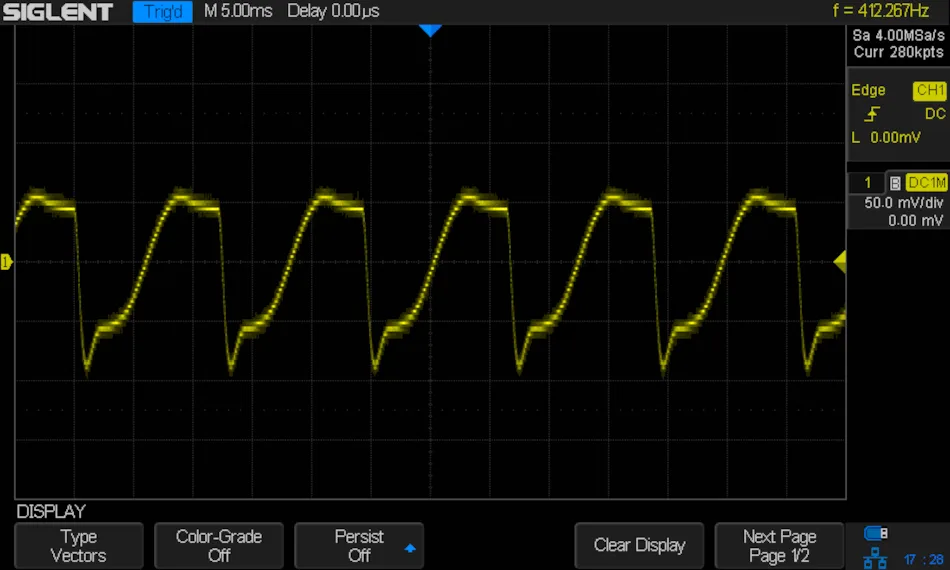
Electric
This one truly shines with pad-type sounds. The ever-changing complex waveforms it uses makes it have a unique timbre. P1 controls the cross-modulation between these, while P2 controls the cross-modulation between the signal and an additional simpler waveform, making a tremolo-like effect.
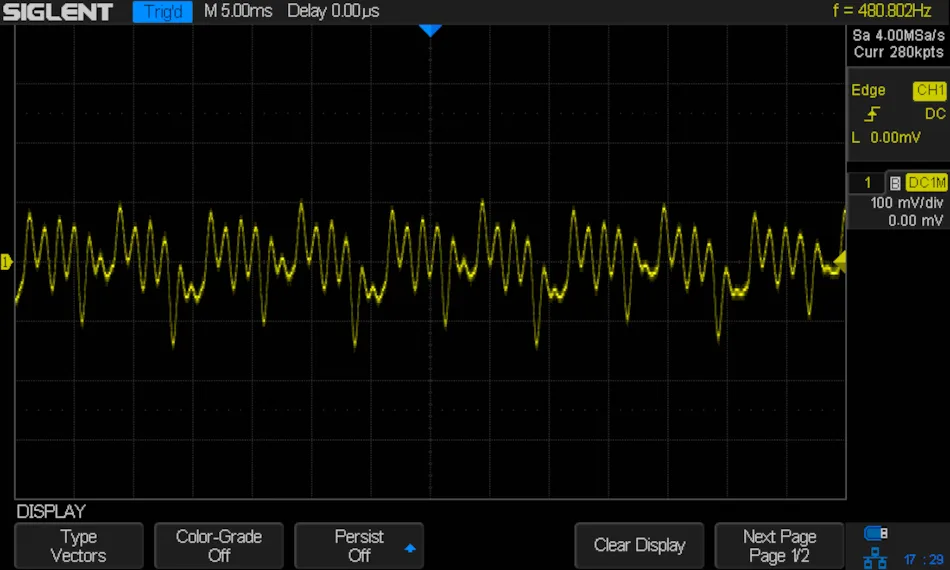
Cluster
Cluster is a lovely engine which uses several closely-detuned oscillators to make a lovely, rich sound. P1 seems to control the tuning of these waves, while P2 seems to be a sort of low-pass filter with just a tiny bit of induced noise. Cluster works great for backing melodies and is one of our favourite engines. It sounds almost nostalgic and distant, yet extremely endearing. Windy pad-type sounds also sound fabulous with it.
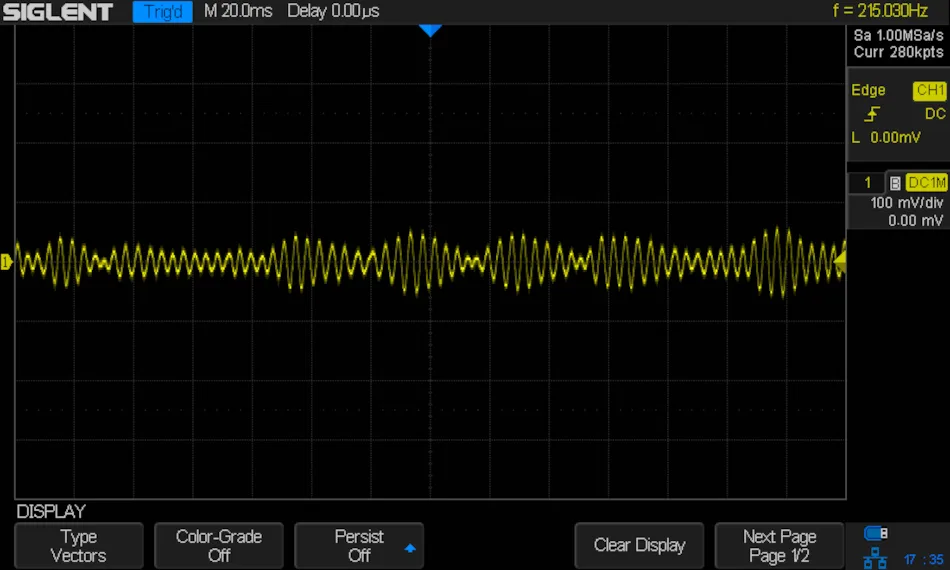
Digital
Digital is the most unique engine on the OP-Z. Hands down. It’s gritty, crazy and almost evil-sounding. And honestly – we have almost no idea about what’s going on the inside here – but it’s crazy and we love it.
Our guess is that it’s a two-oscillator setup, with a main variable-shape (almost wavetable-like) oscillator and a filtered square sub-oscillator. These two sound almost ring-modulated together. P1 changes the sub-oscillator octave, but also introduces some sort of high harmonic noise, almost as if the sub-osc is being modulated with a noise source. P2 changes the shape of the main oscillator from a filtered square to a sawtooth near the middle. After the middle mark, the oscillator starts being heavily distorted, and at P2 values over 90, there’s mostly digital clipping noise. There’s a sweet spot around P2 at 80 where the oscillator sounds extremely musical yet overdriven. Digital works great for bell-like sounds (surprisingly), but especially for electric-guitar-type aggressive leads. It’s truly a gem of a synth.
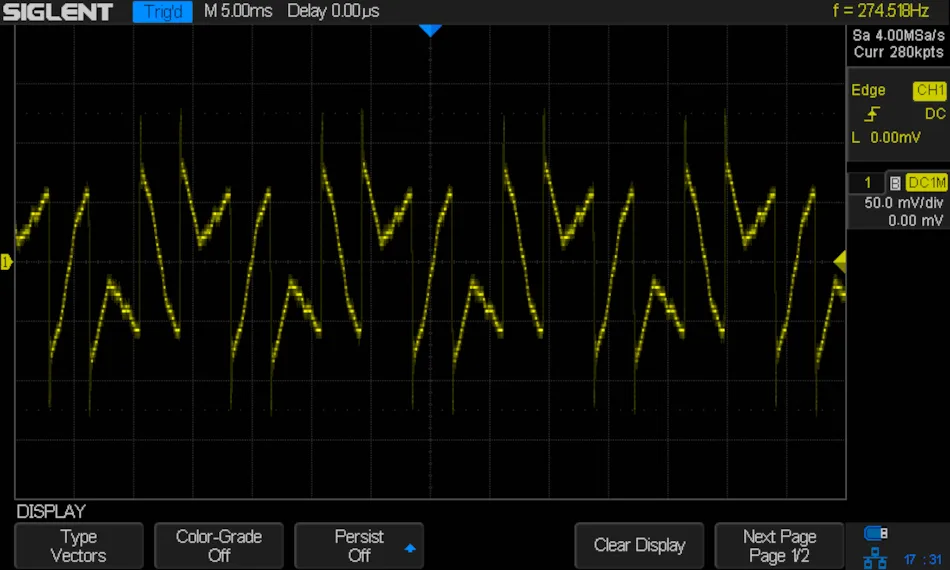
Volt
Volt is a multi-oscillator synth. The main oscillator is a complex one. P1 changes the timbre and shape of it – from an almost Karplus-Strong sounding oscillator to a much brighter sounding mixture with a square-like wave. P2 introduces a bright saw-like wave to the mix, completely overshadowing the original base oscillator. It’s an interesting synth that lends itself great to softer-sounding leads. It’s nothing revolutionary (especially after the madness that was the digital engine), but it’s a welcome staple.
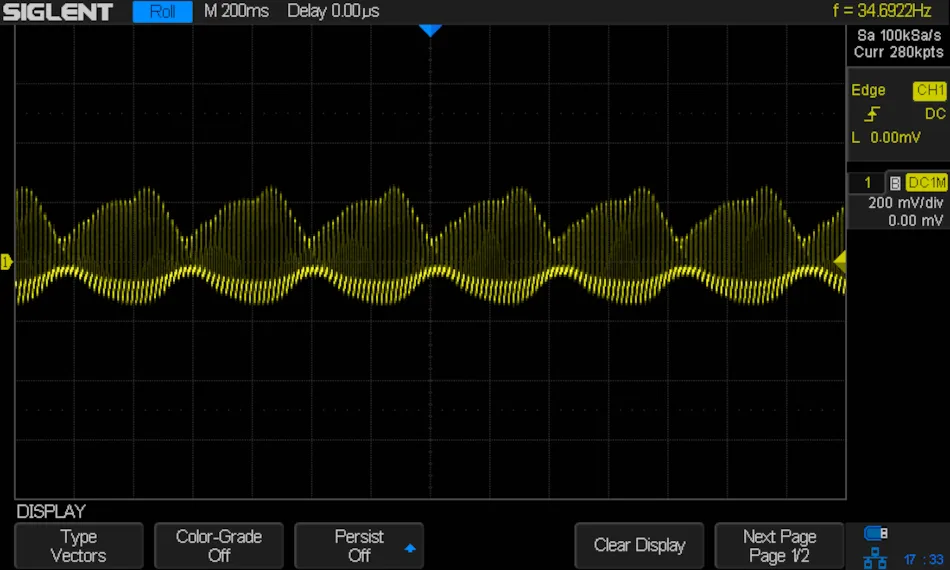
Bow
Here’s an actual Karplus-Strong engine! It’s a pretty rudimentary implementation – with P1 controlling string tension (although, the range here is pretty great – from soft nylon-sounding plucks to thick steel-like percussive sounds) and P2 adjusting the amount of chorus applied. It’s simple but perfectly serviceable – and a great choice for arps or other quick passages, given how well it cuts through the texture.
The inclusion of a chorus parameter and the nature of the synth sound itself also somewhat lessen the need for an LFO – something the arp track doesn’t include (more on that later), thus further making bow one of the better choices for it.
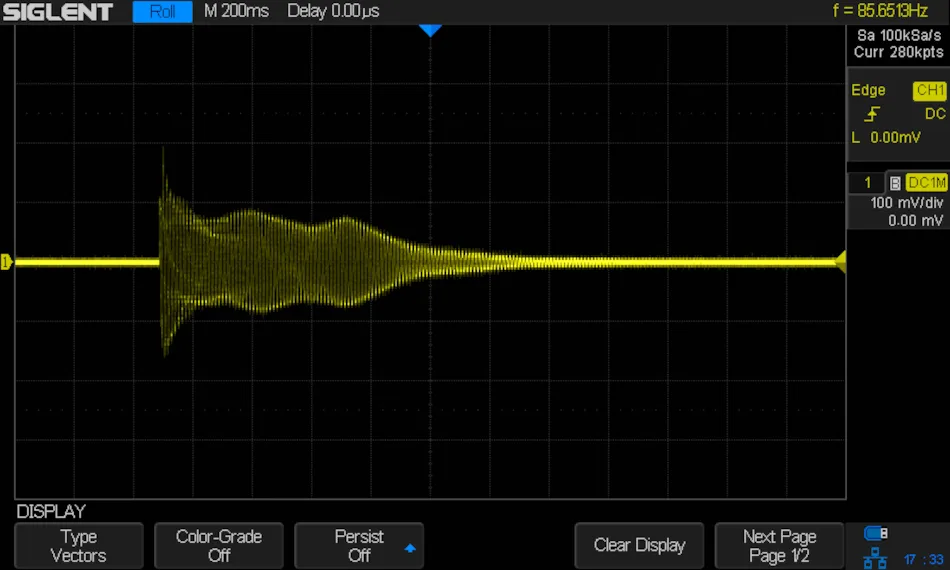
Analog
Analog is a creative implementation of the classic analogue sound profile. Combining a sawtooth with a sub-oscillator and a filtered noise generator made for a pretty versatile analog-style instrument. There’s a lot to like here, especially given how melodic sounding even the noisiest produced sounds are. P1 controls the sub-osc, while P2 controls the noise envelope. Analog works great for bass sounds, where the noise parameter adds a bit of top-end spice to break any possible muddiness, but also works great for soft 80s style leads.
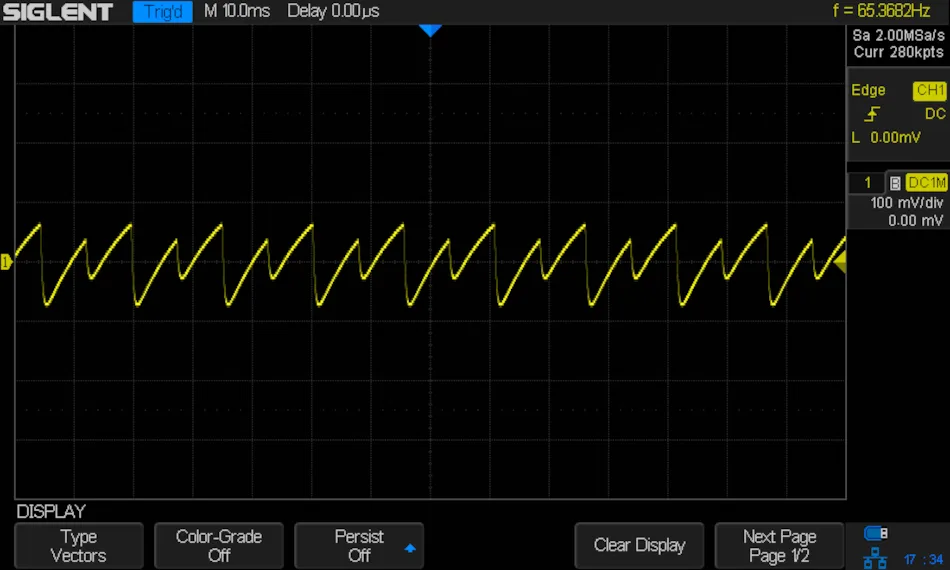
Uranus
Uranus is a bass engine, providing rich and plucky sounding basses. P1 controls the brightness of the main oscillator, while P2 sounds like a soft overdrive. Uranus is a pretty soft-sounding synth which works great when paired with Bow and Cluster. Saw is a better option when the bass has to cut through a rich texture, but this great-sounding bass still has a great presence, even if it’s quite a mellow, clean synth.
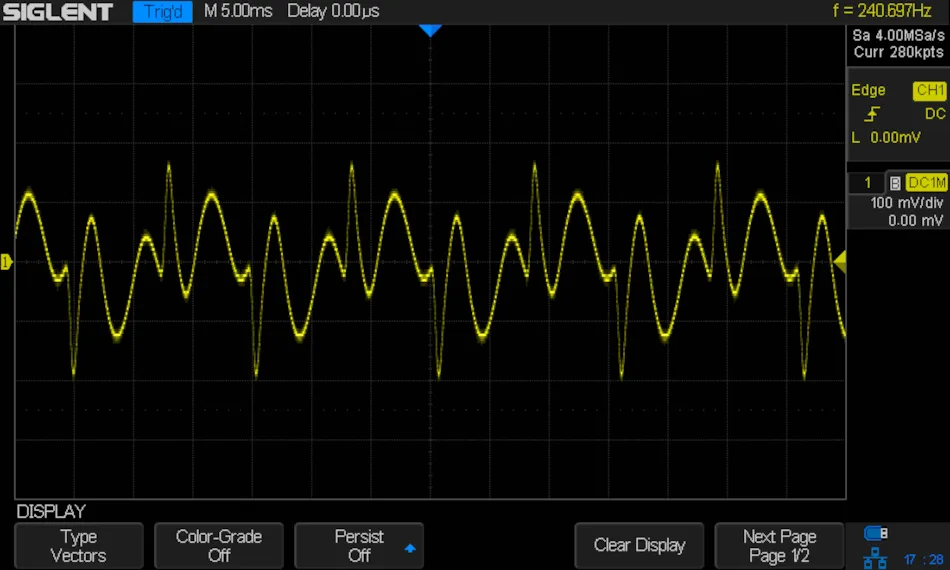
EP and Organ
EP and Organ are classic FM synths modelled after traditional Rhodes-style electric pianos and jazz/rock electric organs. P1 changes the selected algorithm in both, in discrete steps. P2 brightens the tone and produces more harmonics in the EP synth, while in the Organ synth it slightly tweaks the algorithm. Both of these are about what you’d expect. They are brilliantly executed classic and timeless synths which have many different uses.

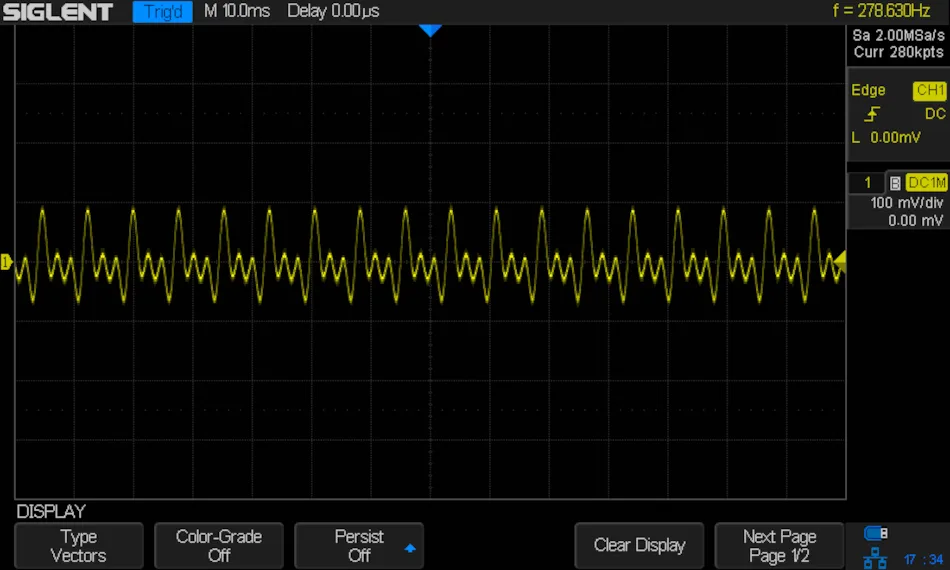
Shade
The penultimate synth of the bunch is the shade synth – an extremely soft electric piano engine which is just heavenly. It sounds so light, fluffy and mellow. We seriously love it!
P1 controls detune (something we missed a bit in the original EP engine) and P2 controls a bell-like drive. Shade sounds like a soft Wurli, but with enough of its own character. Truly a wonderful electric piano synth.
Sampler
The PCM sampler engine allows for quick and easy sampling of external sounds from the built-in microphone. It’s pretty rudimentary but usable. There’s only one parameter here – P1 controlling a bitcrusher. Overall, the synths on the OP-Z offer a creative assortment of sounds, and in general, sound plain good. They are one of the strong points of the system, standing equally as tall as the amazing sequencer.
Percussion sampler
The percussion sampler is a variant of the PCM sampler. Instead of taking one sample and modulating it, though, it takes a longer sample (or sample pack) and slices it, then mapping those slices into “one-shot” type samples across the keyboard. It’s similar in function to the OP-1’s sampler, so sample packs are cross-compatible and can be imported from a computer via the USB port.
Tracks
OP-Z offers 16 tracks total – 8 of which are instrument tracks and 8 of which are miscellaneous. Those instrument tracks are then split into 4 drum tracks – bass drum, snare, hi-hat and FX, each of which can load a sample pack into its sampler. The 4 instrument tracks are separated into bass, lead, arp and chord. They can each load one synth engine at a time. They are all identical, with the exception of the arp track lacking an LFO and instead featuring an arpeggiator that can be turned off. This is a weird limitation, but it’s not horrible.
The next eight tracks are unique ones. We start off pretty standard with two FX racks. These can hold one of six effects (crush, delay, distortion, digital reverb, classic reverb and chorus). Each instrument track can send to both of these. The parameters regarding effects are also to be set within these tracks – and they can, naturally, be sequenced using parameter locks – which is a truly powerful feature.
After the FX racks, comes the unique tape track. Unlike the tape on the OP-1, the tape track on the OP-Z isn’t used for recording. Instead, it’s best imagined as a looping piece of tape that keeps the last set amount of playback in memory – from which those can be manipulated for tape-like effects or just general sequence manipulation. It’s a unique and whimsical feature which always ends up producing unexpected results that oftentimes sound great. Like all tracks on the OP-Z, it can be sequenced in the standard manner.
Next is the master track. It’s used for applying master effects to the entire mixdown, as well as quick modulation options for chord progressions. It’s a powerful tool enabling shorter sequences more variety.
After the master track, comes the performance track, offering the aforementioned punch-in effects to entire instrument groups – as opposed to single instrument effects offered inside the instrument tracks.
The final three tracks are the module track, light track, and motion track. We’ll talk more about the module track in one of the next review chapters. The light track enables DMX light sequencing through a converter box, and the motion track integrates with a Unity-based API designed for visualising the music and parameters on the OP-Z in a fun way. These tracks can send MIDI out on their channels when they aren’t used for their default purposes, which is a great bonus.
The App
The companion app is pretty simple and sleek. It offers data visualisation at a glance and makes operating the OP-Z a breeze. The app never gets in the way, and we love the decision to not allow the app to make any changes to sound parameters – it’s there only for visualisation. This is great – as it cements the idea of the OP-Z being a standalone device. It truly isn’t dependent upon the app – and there’s nothing the app can show that the OP-Z’s LEDs can’t. Once you learn the pages of parameters and the colour codes that signify them, it’s quicker to look at the device itself. The app is used for installing new sample packs and synth engines, as well. It’s also used for configuring some MIDI settings and certain general OP-Z settings.
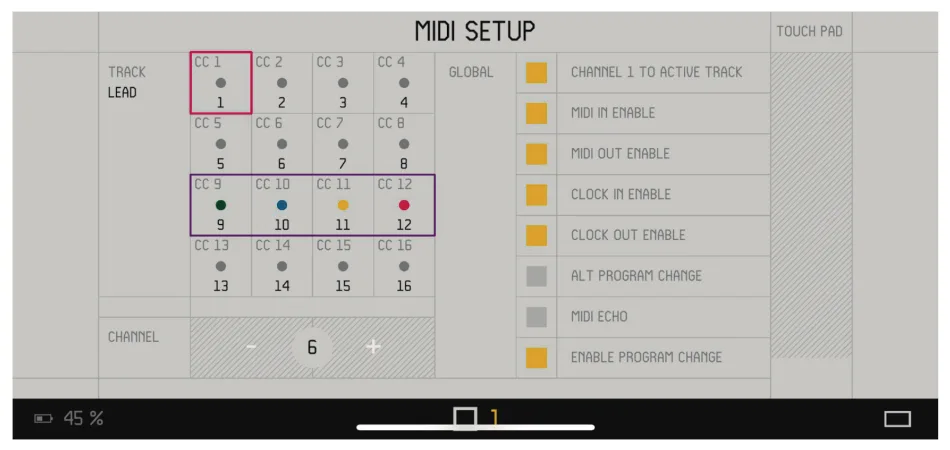

Motion and Photomatic are two fun app options that allow for tweaking on-screen imagery and graphics along with your performance. Photomatic lets you tweak some rudimentary image parameters, like saturation and brightness, while Motion controls Unity-based visualisers which are fun and pretty mesmerising to play around with.
The oplab module
Teenage engineering has also sent us the oplab module – which slots into the back of the OP-Z and expands its connectivity. It offers MIDI in and out, PO sync and trig in and out, as well as 3 analog CV channels and one analog gate channel. There are two other modules available for the OP-Z – the rumble module (which adds sub-bass haptic response to the unit) and the new line module (MIDI in and out + line in and out).
Yeah. On top of everything the OP-Z can do, it now can also interface with outboard gear. While a stock OP-Z can send MIDI through USB or Bluetooth, it usually requires a computer and a MIDI box to be able to send the signal to other hardware, and there’s also the constant issue of latency. A solution that connects to the motherboard of the instrument alleviates all of these, and also provides these features in an easily portable format.

A bit of a digression here – the oplab module takes its name from the oplab. It’s a now discontinued product that allowed you to interconnect quite a few things in the studio – and also offered a lot of hardware-level hacking options. With its demise, TE was left without a connectivity hub of their own – until the oplab module.
So – what can the oplab module interface with exactly? For starters, the MIDI interface makes using external keyboards a breeze, as well as controlling synths equipped with a MIDI in. The PO sync is teenage engineering’s proprietary protocol for syncing up the timing with pocket operator units. The three-CV one-gate solution for analog control is interesting. The design suggests that only one CV is meant to be used for melodic sequencing, with the other two, controllable by the rotary encoders meant for parameters. These can be sequenced with parameter locks, but it’s far from a wieldy solution. The oplab module’s trigger IO can be used to progress the sequence forward manually, enabling more versatility in timing when used with analog systems.
In order to get access to CV2 and CV3, you need stereo splitter cables. 3.5mm to 3.5mm ones – which are somewhat difficult to find. We ended up opting for the official ones – which aren’t too expensive (they are the same type as the gorgeous silicone cables we’ve also gotten with the POM-400), but it’s still a thing to keep in mind – make sure you order the cables if you need the extra functionality!
The data sent out from the module is controlled from the module track, allowing most of it to be sequenced. It’s also worth noting that the OP-Z can be used as a rudimentary MIDI-to-CV converter thanks to the MIDI echo option in settings.
Overall, the oplab module is absolutely amazing, and we feel like it transforms the OP-Z into a device that’s miles above what it originally was – and it was a beast to begin with! Having the power to interconnect and sequence all kinds of gear with a tiny, portable box is just incredible – and it certainly makes the entire package that much more appealing.
Examples
We’ve created several little examples to show off what’s possible with the OP-Z and oplab module – and also demonstrate some specific concepts.
There’s a full-length track we created to show off the capabilities of the OP-Z to create full, finished tracks. We also did some interesting things here – with several of the patterns using quite a lot of spark step components. We took one such pattern and also used the POM-400 (making a comeback!) and the oplab module to create a quick example of both step components and connectivity. It’s quite impressive how much variety a single pattern can have on here! The step components truly make the tracks come alive – and challenge you to think differently while working.
We also created a small avant-garde sounding track full of quartal harmony – it’s short, but we think it shows that OP-Z is capable of some quite unexpected music styles.
Modern demo track
https://magazinmehatronika.com/muse/Modern_Demo.mp3
oplab demo track
https://magazinmehatronika.com/muse/oplab_Demo.mp3
Project demo track
https://magazinmehatronika.com/muse/Project_Demo.mp3
Conclusion
The OP-Z is brilliant. It’s one of the most ridiculously feature-packed pieces of gear we’ve ever seen, in the best way possible. It somehow crams in an amazing sequencer, powerful synth engines, a sampler – all while being an expandable device. It’s truly a portable, pocketable (actually fits in one of our writer’s jacket pocket) DAW – with a lot of the bells and whistles. Most of the things we’ve created required little to no editing on a PC to sound amazing – and that’s saying a lot for such a tiny device.
And we have to say – even if it was three times the size – it’d still be an impressive bit of kit.
The OP-Z retails for €649, while the oplab module goes for €149.
More informations: https://teenage.engineering


